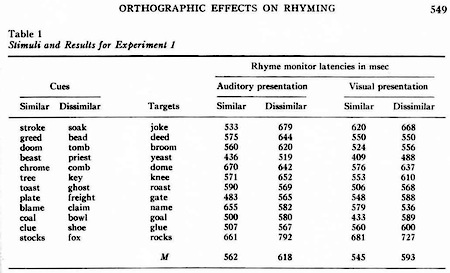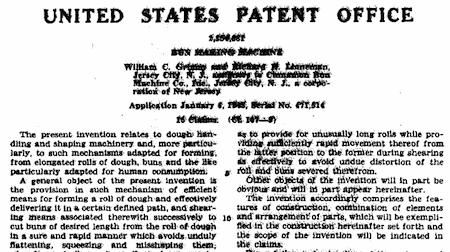Marc Abrahams's Blog, page 249
September 25, 2016
Orthographic effects on rhyme monitoring
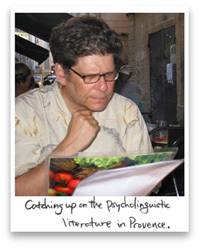 Rhyme monitoring offers countless opportunities for a watchful person. A few of those opportunities were seized, resulting in this study:
Rhyme monitoring offers countless opportunities for a watchful person. A few of those opportunities were seized, resulting in this study:
“Orthographic effects on rhyme monitoring,” Mark S. Seidenberg [pictured here] and Michael K. Tanenhaus, Journal of Experimental Psychology: Human Learning and Memory, vol. 5, no. 6, 1979, pp. 546-54.
Here’s detail from the study:

September 23, 2016
Announcing the 2016 Ig Nobel Prize winners!
Ten new Ig Nobel Prizes were awarded last night (September 22, 2016), at the 26th First Annual Ig Nobel Prize ceremony, at Harvard University’s Sanders Theatre. The prizes honor achievements that make people LAUGH, then THINK.
Here’s video of the entire ceremony:
Tomorrow, the new Ig Nobel Prize winners will give short public talks, and answer questions:
The Ig Informal Lectures
Saturday, Sep 24, 2016, 1:00 pm
MIT, building 26, room 100.
FREE admission, but seating is limited (so get there early)

September 22, 2016
Watch the 26th First Annual Ig Nobel Prize Ceremony here!
The 26th First Annual Ig Nobel Prize ceremony happens today — Thursday, September 22, 2016.
Watch the live webcast here. The broadcast will start at 5:40 PM US eastern time. The ceremony itself begins at 6:00 PM US Eastern Time.
(Want to attend the ceremony in person, at Harvard University’s Sanders Theatre? Tickets have been sold out for a while now. But it’s possible a few last-minute tickets will become available: (1) check the Harvard Box Office web site; or (2) if you want to take your chances, come to the ticket window in Sanders Theatre one hour prior to the ceremony start.)
Please feel free to livetweet your thoughts, reactions, opinions, happiness, disgust, and genius, using the hashtag #IgNobel.
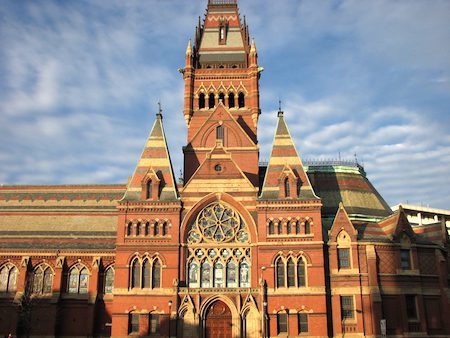

An analysis of CEO shirking (at the golf course)
 CEOs of high-profile (e.g. S&P 1500) corporations are sometimes tempted to shirk their duties. One quite well-tried method of shirking is to leave the office for the day and play golf instead. Thus, as an observer, if you take the position that shirking might in general hamper business performance, an extrapolated question can be asked – ‘Is golf bad for business?’ Researchers Biggerstaff, Cicero and Puckett have investigated such things, and present their findings in a forthcoming paper for the journal Management Science entitled FORE! An analysis of CEO shirking They find that :-
CEOs of high-profile (e.g. S&P 1500) corporations are sometimes tempted to shirk their duties. One quite well-tried method of shirking is to leave the office for the day and play golf instead. Thus, as an observer, if you take the position that shirking might in general hamper business performance, an extrapolated question can be asked – ‘Is golf bad for business?’ Researchers Biggerstaff, Cicero and Puckett have investigated such things, and present their findings in a forthcoming paper for the journal Management Science entitled FORE! An analysis of CEO shirking They find that :-
“CEOs that golf frequently (i.e., those in the top quartile of golf play, who play at least 22 rounds per year) are associated with firms that have lower operating performance and firm values.”
And also :
”Numerous tests accounting for the possible endogenous nature of these relations support a conclusion that CEO shirking causes lower firm performance.”
A full copy of the paper can be found here.
Also see: ‘Optimal shirking’
Bonus: ‘2012 Yearly Golfball Patents: A look back’
Optional assignment Although not investigated in the paper, some take the view that golf is actually good for business – in the sense that high-profile CEOs often encounter other high-profile CEOs at the golf course. Discuss
Note: The picture is ‘The MacDonald boys playing golf ‘ by Jeremiah Davison (1695?–1750?)

Ig Nobel Prize-winning swearing research wins best science book prize
Black Sheep: The Hidden Benefits of Being Bad, a new book by Richard Stephens, is the British Psychological Society’s Book Award winner — in the category Popular Science. The BPS’s Book Awards have just been announced.
The BPS’s Book Awards have just been announced.
In the year 2010, Richard Stephens and two colleagues were awarded the Ig Nobel Peace Prize, for confirming the widely held belief that swearing relieves pain. That research is documented in the study “Swearing as a Response to Pain,” Richard Stephens, John Atkins, and Andrew Kingston, Neuroreport, vol. 20 , no. 12, 2009, pp. 1056-60.
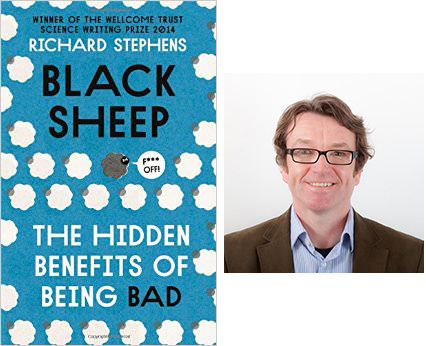
That same research forms part of the backbone of Richard Stephens’ (now prize-winning!) recent book, Black Sheep.
BONUS INFO: There is something of a tradition now of Ig Nobel Prize winners’ books winning prizes. One of the earliest examples: Chris McManus‘s book Right Hand, Left Hand, was awarded the 2003 Aventis Prize as best science book of the year. That book, Right Hand, Left Hand, grew mightily, over many years, from the research that eventually earned McManus the 2002 Ig Nobel Prize for biology. That Ig Nobel Prize was for McManus’s first published scientific paper: “Scrotal Asymmetry in Man and in Ancient Sculpture,” which appeared in the journal Nature, vol. 259, February 5, 1976, p. 426.

September 21, 2016
Podcast 82: “The Best Life — Act 3 (of 3)” — A scientific mini-opera where everything goes wrong.
Act 3 — the spectacular finale of the 3-act mini-opera “The Best Life”, about about a competition to choose the best species of life — that’s this week’s Improbable Research podcast.
SUBSCRIBE on Play.it, iTunes, or Spotify to get a new episode every week, free.
This week, Marc Abrahams introduces the thrilling conclusion of the mini-opera “The Best Life,” which premiered as part of the 2015 Ig Nobel Prize Ceremony, at Harvard’s Sanders Theatre. This is a recording from that performance:
The plot of Act 3: [As you’ll hear the narrator, Karen Hopkin, explain:] The contest never did choose the best form of life. The contest didn’t even happen. Not quite. At the run-through, where ALL the millions of species were gathered together in a single room, the number of deaths, injuries, and infections mounted almost beyond counting. The contest was canceled. This resulted in what you could call “Springtime for Lawyers.” Lawsuits — thousands and thousands of lawsuits — sprung up. Eventually, all the lawyers gathered in a single courtroom, before a single judge. The judge is now going to decide ALL the lawsuits together. And then, if necessary, he will sentence the defendants. Let’s join the judge, and all those lawyers, and the two contest organizers who are on trial — in the thrilling conclusion to the opera.
The libretto: The entire libretto is included in IgBill, the printed program that was handed out to all 1100 people who attended that performance. You can download your own copy of IgBill, and read along as you hear the singers sing and the instrumentalists do whatever it is they are doing.
The creators/producers: The music is by Giuseppe Verdi and Arthur Sullivan, the story and words by Marc Abrahams. The performance was directed by Maria Ferrante, assisted by Robin Abrahams, and costumed by Catherine Quick Spingler.
The performers: starring Maria Ferrante, Scott Taylor, and Daniel Rosenberg,
with The All-Species Chorus — Delphine Gabbay (chorus wrangler), Erika Hutchinson, Sylvia Rosenberg, Julia Lunetta, Vicki Bloom, Ros (Rosalind) Reid, Natasha Rosenberg, Abby Schiff, Vijaya Sundaram, Rob Hart, Liz Oppenheim, Warren Senders, Ted Sharpe, Nick Carstoiu, et al. The chorus ranks were swelled, in Act 3 of the opera, by addition of Nobel laureates Dudley Herschbach (chemistry, 1986), Carol Greider (physiology or medicine, 2009), Frank Wilczek (physics, 2004), Jack Szostak (physiology or medicine, 2009), and Eric Maskin (economics, 2007). The singers were backed by the Concentrated Forces of Nature, a distilled orchestra composed entirely of Harvard Medical School researchers Patrick Yacono and Dr. Thomas Michel.
Libretto plus: The libretto also appears, with photos from opera and juicy details from the entire the Ig Nobel ceremony, in the special 2015 Ig Nobel issue of our magazine, the Annals of Improbable Research. Here’s a photo (by ace photographer David Holzman) from Act 3:
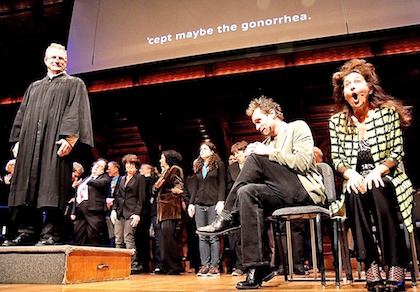
The mysterious John Schedler or the shadowy Bruce Petschek perhaps did the sound engineering this week.
The Improbable Research podcast is all about research that makes people LAUGH, then THINK — real research, about anything and everything, from everywhere —research that may be good or bad, important or trivial, valuable or worthless. CBS distributes it, on the CBS Play.it web site, and on iTunes and Spotify).

Podcast 82: “The Best Life — Act 3 (of 3)” — A scientific mini-opera where everything goes wrong.
Act 3 — the spectacular finale of the 3-act mini-opera “The Best Life”, about about a competition to choose the best species of life — that’s this week’s Improbable Research podcast.
SUBSCRIBE on Play.it, iTunes, or Spotify to get a new episode every week, free.
This week, Marc Abrahams introduces the thrilling conclusion of the mini-opera “The Best Life,” which premiered as part of the 2015 Ig Nobel Prize Ceremony, at Harvard’s Sanders Theatre. This is a recording from that performance:
The plot of Act 3: [As you’ll hear the narrator, Karen Hopkin, explain:] The contest never did choose the best form of life. The contest didn’t even happen. Not quite. At the run-through, where ALL the millions of species were gathered together in a single room, the number of deaths, injuries, and infections mounted almost beyond counting. The contest was canceled. This resulted in what you could call “Springtime for Lawyers.” Lawsuits — thousands and thousands of lawsuits — sprung up. Eventually, all the lawyers gathered in a single courtroom, before a single judge. The judge is now going to decide ALL the lawsuits together. And then, if necessary, he will sentence the defendants. Let’s join the judge, and all those lawyers, and the two contest organizers who are on trial — in the thrilling conclusion to the opera.
The libretto: The entire libretto is included in IgBill, the printed program that was handed out to all 1100 people who attended that performance. You can download your own copy of IgBill, and read along as you hear the singers sing and the instrumentalists do whatever it is they are doing.
The creators/producers: The music is by Giuseppe Verdi and Arthur Sullivan, the story and words by Marc Abrahams. The performance was directed by Maria Ferrante, assisted by Robin Abrahams, and costumed by Catherine Quick Spingler.
The performers: starring Maria Ferrante, Scott Taylor, and Daniel Rosenberg,
with The All-Species Chorus — Delphine Gabbay (chorus wrangler), Erika Hutchinson, Sylvia Rosenberg, Julia Lunetta, Vicki Bloom, Ros (Rosalind) Reid, Natasha Rosenberg, Abby Schiff, Vijaya Sundaram, Rob Hart, Liz Oppenheim, Warren Senders, Ted Sharpe, Nick Carstoiu, et al. The chorus ranks were swelled, in Act 3 of the opera, by addition of Nobel laureates Dudley Herschbach (chemistry, 1986), Carol Greider (physiology or medicine, 2009), Frank Wilczek (physics, 2004), Jack Szostak (physiology or medicine, 2009), and Eric Maskin (economics, 2007). The singers were backed by the Concentrated Forces of Nature, a distilled orchestra composed entirely of Harvard Medical School researchers Patrick Yacono and Dr. Thomas Michel.
Libretto plus: The libretto also appears, with photos from opera and juicy details from the entire the Ig Nobel ceremony, in the special 2015 Ig Nobel issue of our magazine, the Annals of Improbable Research. Here’s a photo (by ace photographer David Holzman) from Act 3:

The mysterious John Schedler or the shadowy Bruce Petschek perhaps did the sound engineering this week.
The Improbable Research podcast is all about research that makes people LAUGH, then THINK — real research, about anything and everything, from everywhere —research that may be good or bad, important or trivial, valuable or worthless. CBS distributes it, on the CBS Play.it web site, and on iTunes and Spotify).

THURSDAY: The 26th First Annual Ig Nobel Prize ceremony (and webcast)
The 26th First Annual Ig Nobel Prize ceremony happens tomorrow, Thursday, September 22, 2016, beginning at 6 pm (US eastern time).
A very few TICKETS for the ceremony might become available — check the Harvard Box Office for those.
The webcast begins at 5:40 pm, with the ceremony itself beginning at 6:00.
The theme of this year’s ceremony (though not necessarily of the things that win prizes!) is TIME. The ceremony will include the premiere of a new mini-opera, “The Last Second”, about a plot to secretly add an extra leap second to the world’s clocks, and secretly reap the financial benefits.

Removal of a 9-Ring Personal Testicle Device, Medically, in Detail
This newly published medical report, which tells how doctors removed a nine-ring personal testicle device from the testicles of the person who had too-successfully used that device, demonstrates how to almost gracefully write (1) a clear headline and also (2) a clear summary:
“Scrotum Incarceration with Nine Galvanized Iron Rings: An Unusual Case Report,” Ying-Chen Chou, Chi-Wen Juan, Tsung-Hsing Lin, Chih-Wei Tsai, and Choon-Hoon Hii, Journal of Acute Medicine, epub September 19, 2016. The authors, at Kuang Tien General Hospital, Taichung, Taiwan, report:
“In this case report we describe the case of a 36-year-old male who presented to the emergency department with a grossly swollen scrotum. Nine galvanized iron rings were placed around his scrotum for the enhancement of his sexual performance. Attempts to remove them with lubricants, ring cutters, pliers, and orthopedic bone cutters were unsuccessful. Finally, they were removed with a hydraulic bolt cutter borrowed from the fire department. Genital incarceration or strangulation represents a true urological emergency. Removal of such devices can be challenging for emergency physicians and often requires resourcefulness and a multidisciplinary approach.”
The paper goes on to give full details. Here are before-removal and after-removal views of the nine rings:
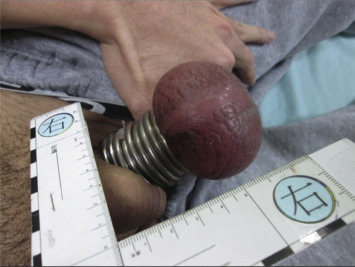
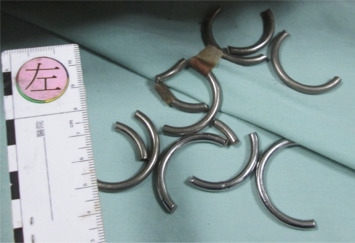
(Thanks to Frank Swain for bringing this to our attention.)
BONUS (possibly unrelated): Here’s video of Barry Biggs performing the song “Three Ring Circus”:

September 20, 2016
Grimm’s Bum-Making Machine
W.T. Grimm and his non-Grimm partner did not obtain a patent for a bum-making machine. The bleariness of the scanned patent document only makes it look that way. The patent is now listed as:
“Bum making machine,” US patent # 2354681, granted to W.C. Grimm et al. on August 1, 1944.

Marc Abrahams's Blog
- Marc Abrahams's profile
- 14 followers


